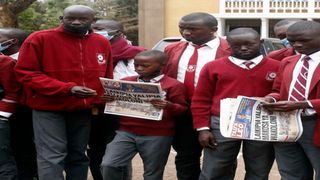
Students at Lenana School peruse through a copy of the Taifa Leo newspaper on September 11.
| File | Nation Media GroupEducation
Premium
High transition but low retention rate as learners drop out in high school
Hundreds of thousands of learners have been dropping out of the education system annually despite the much-hyped 100 per cent transition policy introduced by the government in 2017.
The Economic Survey 2021 released two weeks ago shows that 204,690 of candidates who sat the Kenya Certificate of Primary Education (KCPE) exam in 2016 did not get to Form Four to sit the 2020 Kenya Certificate of Secondary Education (KCSE).
Much focus has been on entry to Form One but it now emerges that retention in school is a serious challenge for the government.
By the end of last year, out of the 993,718 candidates who sat KCPE in 2017, 124,818 had dropped out. The number might even be lower if the Kenya National Examinations Council (Knec) releases data on the registered candidates for the 2021 examinations that will be administered in March and April next year.
The next cohort of 1,060,710 candidates who sat the 2018 KCPE saw 861,400 report to Form One.
Curiously, the report shows an increased enrolment of 922,400 when the class transitioned to Form Two last year. There was no data for Form Threes.
The class that completed primary school in 2019 also saw 107,489 learners fail to join Form One. There were 1,088,989 candidates that year. Data on their current number was also unavailable.
Wastage of resources
Failure to complete school amounts to wastage of resources for both the government and families, as well as lost opportunities. The government spends Sh22,244 in capitation per learner in secondary school. Families cater for other expenses like uniform, boarding and meals.
Various reasons, among them teenage pregnancies, death and lack of school fees have been advanced for the low retention.
When the transition policy was introduced, the Ministry of Education roped in chiefs and Nyumba Kumi leaders to enlist learners in secondary schools.
Enrolment in primary has also been erratic. By the end of last year, there were 10,170,100 learners in primary, much lower than 2016 (10,279,700). In 2017, there were 10,403,700, 10,542,500 in 2018 and 10,072,000 in 2019. The ministry last year admitted that headteachers had been inflating numbers to steal capitation cash. Enrolment in secondary schools jumped from 2,720,600 in 2016 to 3,520,400 last year, with the increase being more progressive, unlike that of primary schools.
The data shows that, although the objective is yet to be achieved, the transition rate has been increasing since 2016. Another cause for worry is the number of secondary schools as the population continues to grow, leading to congestion.
In the years under review, the secondary school population has grown by 799,800, while only 520 new public schools have been constructed. Some 49 private schools were shut down.
In 2016, the pupil completion rate in primary schools stood at 83.5 per cent, while the transition rate was 81.3 per cent.
In 2017, the pupil completion rate increased to 84 per cent, while transition rate moved to 83.1 per cent. In 2018, the pupil completion rate was 84.2 per cent and transition rate 83.3 per cent, while in 2019, the completion rate was 85.4 per cent with the transition rate at 85.5 per cent.
Last year, the pupil completion rate increased to 94.6 per cent, while the transition rate moved to 91 per cent.
This year, 26,564 learners are yet to report to Form One. This is despite Education Cabinet Secretary George Magoha saying the transition rate stood at 98 per cent. A total of 1,171,265 had been selected to join Form One but only 1,129,637 reported. Some 15,064 joined Technical and Vocational institutions (Tvets), while others repeated Standard 8.
Low completion
Kenya Secondary Schools Heads Association (Kessha) chair Kahi Indimuli blamed the low completion rate on lack of school fees.
“After a year or two, sponsors and guardians withdraw their support, making it difficult for students to continue with classes, especially those in boarding schools,” he said. In other areas, students are affected by mobile schools and early marriages. The Kibaki administration introduced free primary education in 2003. It spends Sh1,420 per primary school learner in capitation annually.
The government further introduced the free day secondary school in 2017 and committed to pay tuition fees for all students.
Under the programme, Sh22,244 is spent per learner.
Those in boarding schools pay extra money to cater for other services as per the ministry’s fee guidelines, depending on the category of the school.
For the second year running, the government awarded 9,000 scholarships to needy and bright students through the Elimu Scholarships programme although thousands of other deserving cases were left out. County governments also provide scholarships and bursaries.






